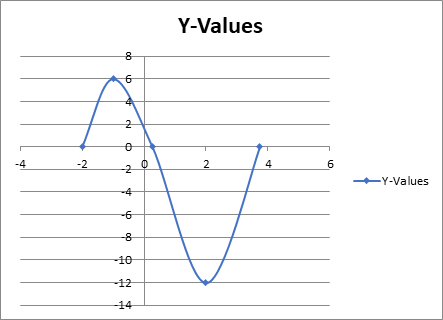
Concept explainers
a.
To use the zero or root feature of a graphing utility to approximate (accurate to the nearest thousands) the zeros of the function.
a.
Answer to Problem 101E
Explanation of Solution
Given: Given function is
Concept Used:
Zeros are the values for x for which function gives zero value.
Calculation: To graph the function calculates the following points of the graph.
| t | h(t) |
| -2 | 0 |
| -1 | 6 |
| 0.268 | 0 |
| 2 | -12 |
| 3.732 | 0 |
Graph the function on the above points

Where x- axis represents t and y -axis represents h(t).
b.
To find one of the exact zeros and use synthetic division to verify result.
b.
Answer to Problem 101E
t =-2 an exact zero of the given polynomial function.
Explanation of Solution
Given: Given function is
Concept Used:
Synthetic division is used here.
Calculation:
t =-2 looks like an exact zero. Confirm with synthetic division.
Using the bottom row as coefficient of the resulting polynomial from dividing h by (t +2).
c.
To factor the polynomial completely..
c.
Answer to Problem 101E
The complete factorization is,
Explanation of Solution
Given: Given function is
Concept Used:
Use the
Calculation:
The complete factorization is,
Chapter 2 Solutions
Precalculus with Limits: A Graphing Approach
 Calculus: Early TranscendentalsCalculusISBN:9781285741550Author:James StewartPublisher:Cengage Learning
Calculus: Early TranscendentalsCalculusISBN:9781285741550Author:James StewartPublisher:Cengage Learning Thomas' Calculus (14th Edition)CalculusISBN:9780134438986Author:Joel R. Hass, Christopher E. Heil, Maurice D. WeirPublisher:PEARSON
Thomas' Calculus (14th Edition)CalculusISBN:9780134438986Author:Joel R. Hass, Christopher E. Heil, Maurice D. WeirPublisher:PEARSON Calculus: Early Transcendentals (3rd Edition)CalculusISBN:9780134763644Author:William L. Briggs, Lyle Cochran, Bernard Gillett, Eric SchulzPublisher:PEARSON
Calculus: Early Transcendentals (3rd Edition)CalculusISBN:9780134763644Author:William L. Briggs, Lyle Cochran, Bernard Gillett, Eric SchulzPublisher:PEARSON Calculus: Early TranscendentalsCalculusISBN:9781319050740Author:Jon Rogawski, Colin Adams, Robert FranzosaPublisher:W. H. Freeman
Calculus: Early TranscendentalsCalculusISBN:9781319050740Author:Jon Rogawski, Colin Adams, Robert FranzosaPublisher:W. H. Freeman
 Calculus: Early Transcendental FunctionsCalculusISBN:9781337552516Author:Ron Larson, Bruce H. EdwardsPublisher:Cengage Learning
Calculus: Early Transcendental FunctionsCalculusISBN:9781337552516Author:Ron Larson, Bruce H. EdwardsPublisher:Cengage Learning





